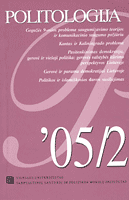Šiuolaikiniai Socialiniai Judëjimai
Modern Social Movements
Author(s): Kæstutis PaulauskasSubject(s): Cultural Essay, Political Essay, Societal Essay
Published by: Vilniaus universiteto leidykla & VU Tarptautinių santykių ir politikos mokslų institutas
Summary/Abstract: Anti-globalist riots in Seattle in 1999 and the global anti-war demonstrations in 2003 not only made their way to the news headlines, but also received renewed academic attention. This article seeks to outline the differences between the traditional social movements and the new social movements. The first part of the article addresses the definition and classification issues of social movements. It also presents a comparison of three theoretical approaches (rational choice, Marxism and social constructivism) towards the phenomenon of social movement. The author concludes, that advocates of all three approaches present certain valuable insights on the causes and effects of this phenomenon. The second chapter of the article outlines presents trends and problems in the research of the social movements. It is argued that researchers of this subject face basically the same problems as all social scientists, first of the problems of comparability and the limits of qualitative methods. On the other it is assessed that new tools of quantitative analysis, information technologies significantly enhance the possibilities of research. By combining different theoretical approaches the author then seeks to outline the criteria of what could be the constitutive elements of the new social movements as opposed to the traditional ones. It is concluded that the new social movements can only exist in the postmodern or post-materialist societies where the questions of physical survival or national liberation are replaced by the questions of quality of life and self-expression. The new movements are also transnational in nature and their goals are usually universal (ecology, peace, rights of animals) rather than national (independence) or individual (employment, salary etc.). The new movements mobilize around collective identity and common values while the traditional movements mobilize around common goals of social or economic changes. The organization mode of the new movements is usually horizontal and the role of the leaders is rather limited while in the case of traditional movements the organization structure is strictly hierarchical and the role of the leader is essential. Finally the new movements are less prone to violence and rely more on the new technologies of communication and information. Building on the criteria outlined in the second part of the article, the final chapter discusses the case of Lithuania. It is concluded that the number and activities of the new social movements in Lithuania are very scarce. The most significant among such movements is the feminist movement, which is indeed rather active, and even have established ties with international feminist network. Traditional movements (in particular farmers, nationalists and neo-nazists, are still abundant in Lithuania. The authors argues that such imbalance between traditional and new movements could be a cause for concern.
Journal: Politologija
- Issue Year: 2004
- Issue No: 4 (36)
- Page Range: 110-134
- Page Count: 25
- Language: Lithuanian

